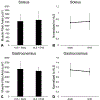Comparison of morphological changes of muscle fibers in response to dynamic electrical muscle contraction and dynamic hydraulic stimulation in a rat hindlimb disuse model
- PMID: 28248540
- PMCID: PMC6945807
- DOI: 10.33549/physiolres.933101
Comparison of morphological changes of muscle fibers in response to dynamic electrical muscle contraction and dynamic hydraulic stimulation in a rat hindlimb disuse model
Abstract
This study attempted to compare the muscle fiber morphological responses to dynamic electrical muscle stimulation (DEMS) and dynamic hydraulic stimulation (DHS) in rats under hindlimb suspension (HLS). DEMS at 1 Hz, 50 Hz and 100 Hz for 10 min/day, 5 days/week were introduced to the animals' right quadriceps. Static and 2 Hz DHS were introduced to the right tibiae of other animal groups on a "10 min on - 5 min off - 10 min on" loading regime for 5 days/week. In the end of the 4-week experiments, histological changes in the corresponding soleus, gastrocnemius and quadriceps of the stimulated sites were examined. Compared to age-matched, HLS led to muscle atrophy and strongly reduced muscle wet weights and averaged cross-sectional fiber areas. Among the tested DEMS frequencies, the averaged cross-sectional quadriceps fiber area in the 50 Hz group was 29 % larger than the 100 Hz group. In contrast, difference in the muscle fiber response to the static and 2 Hz DHS was not observed in either soleus or gastrocnemius. Muscle fiber morphological responses to the active DEMS was in a load frequency dependent manner under disuse condition. Relatively passive compressions, either via static or 2Hz DHS, were unable to induce any difference in the muscle fiber responses under functional disuse.
Conflict of interest statement
Conflict of Interest
There is no conflict of interest.
Figures





Similar articles
-
The effects of frequency-dependent dynamic muscle stimulation on inhibition of trabecular bone loss in a disuse model.Bone. 2008 Dec;43(6):1093-100. doi: 10.1016/j.bone.2008.07.253. Epub 2008 Aug 13. Bone. 2008. PMID: 18757047 Free PMC article.
-
Low amplitude, high frequency strains imposed by electrically stimulated skeletal muscle retards the development of osteopenia in the tibiae of hindlimb suspended rats.Med Eng Phys. 2005 May;27(4):285-93. doi: 10.1016/j.medengphy.2004.12.014. Med Eng Phys. 2005. PMID: 15823469
-
Dynamic hydraulic flow stimulation on mitigation of trabecular bone loss in a rat functional disuse model.Bone. 2012 Oct;51(4):819-25. doi: 10.1016/j.bone.2012.06.030. Epub 2012 Jul 20. Bone. 2012. PMID: 22820398 Free PMC article.
-
Effect of inactivity and undernutrition after acute ischemic stroke in a rat hindlimb muscle model.Nurs Res. 2004 Sep-Oct;53(5):283-92. doi: 10.1097/00006199-200409000-00001. Nurs Res. 2004. PMID: 15385863
-
The determinants of skeletal muscle force and power: their adaptability with changes in activity pattern.J Biomech. 1991;24 Suppl 1:111-22. doi: 10.1016/0021-9290(91)90382-w. J Biomech. 1991. PMID: 1791172 Review.
References
-
- ALLEN MR, BLOOMFIELD SA: Hindlimb unloading has a greater effect on cortical compared with cancellous bone in mature female rats. J Appl Physiol 94: 642–650, 2003. - PubMed
-
- ASMUSSEN G, SOUKUP T: Arrest of developmental conversion of type II to type I fibres after suspension hypokinesia. Histochem J 23: 312–322, 1991. - PubMed
-
- BALDI JC, JACKSON RD, MORAILLE R, MYSIW WJ: Muscle atrophy is prevented in patients with acute spinal cord injury using functional electrical stimulation. Spinal Cord 36: 463–469, 1998. - PubMed
-
- BOONYAROM O, INUI K: Atrophy and hypertrophy of skeletal muscles: structural and functional aspects. Acta Physiol (Oxf) 188: 77–89, 2006. - PubMed
